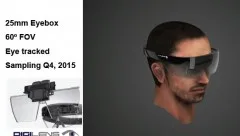
Jonathan Waldern is CEO of Digilens which has a new kind of material for waveguide optics. He started by asking “who has heard of Google Glass?” – who has tried it, and who would buy it? The audience clearly showed that it wasn’t ready to buy!
The waveguide optics of Digilens are different from refractive optics, which means that there is a lack of tools and systems for development. The waveguides are used in augmented reality (AR) and, to a lesser degree, virtual reality (VR).
The system uses a high index polymer to introduce structures to the lenses used in AR & VR headsets to direct light in the system and into the eye.
Digilens is working with Rockwell Collins to develop a head mount system for avionics. The image is injected into the edge of an optical combiner then moves through the lens with TIR until it meets the optical elements. Waldern said that it can make 94% transparent Bragg gratings – which can be up to 100% efficient.
The company can replace traditional projectors with holographic projectors and that can help to move the use of HUDs down into much smaller aircraft. Waldern said that having a HUD allows flying in more difficult weather conditions and in some cases, it increases operations of planes by up to 20%. That’s a big cost saving.
The Digilens product is made from a sandwich of flexible Corning Willow glass, with liquid crystal (LC) material in between. The LC material is solidified by dual laser beams that meet where polymerisation is desired. The use of LC means that optics can be optically erased.

The system can be used in night vision – the lens system allows a change in the point of focus of the headset image and Waldern said that this change of focus alone had stopped travel sickness in military users of headsets in combat vehicles.
In automotive HUD applications, you can use the gratings to grow the image – so that the space taken by the projector is around 1L rather than the 9L of traditional projectors. Waldern wondered whether the waveguide could be created in the windscreen?
In A/R the ‘little sugar cube’ of GGlass has only a 6/7mm eye box and that is a problem if you move your eye out of the area. Large eye boxes historically need large lenses, but with Digilens, you could create an eye box of 25mm. You need a wide Field of View and 60º is achievable in the next reference design that the firm plans to launch at the end of 2015.

Waldern differentiates between “soft” A/R where there is an overlay of information in front of you that blends with the image of the real world and “hard” AR – like MS Hololens which adds objects in the world that you are looking at. In hard AR, you need to block the light from the real world behind the objects shown, so it’s not a ‘ghost’ image of an object that you see. It looks like a real object.
Digilens has had to develop its own range of tools to model the optics – these tools are supplied to customers to help develop optical solutions. There are a whole range of optical functions available so you can create beam splitters or beam extractors, etc. There’s a Rolled K structure that can move the light around to make a “system in a waveguide” with a nearly 25mm² exit pupil.
A night vision system is being developed for the US defence industry and has a 40º FOV – increasing to 60º with the next iteration of the design (Waldern said that this is the limit for the foreseeable future – it’s to do with the glass). Making colour systems is harder – you need two optical layers – one for red and the other for a blue/green channel.
The optical structures can also be used for gaze tracking. His firm has developed 300Hz tracking at 1550nm which allows a higher flux, but safe light with the advantage that you never see it because of the long wavelength.
Waldern referred to the idea of using gaze tracking for what he called “foveated imaging”. By knowing where you are looking, you can render just a part of the image which may be as little as 6% of the scene. There are then big savings in power consumption or an improvement in 5º gaze detail. Waldern said that conventional eyetrackers cannot do this and CMOS imagers cannot detect 1550nm.
He also said that Microsoft’s Hololens has a problem with field of view. if objects disappear out of the user’s FOV, the AR reality is disrupted. That means that very wide field of view is needed. It seems that Vuzix and Microsoft use surface relief gratings (based on technology licensed from Nokia) and that will limit their field of view.
Bayer Holographics is the nearest to the Digilens performance but is said to be 3X lower.
Previously, Digilens has been concentrating on military applications, but is now going to industrial and later consumer products.
In response to questions, Waldern said that “later” there will be curved displays using Digilens technology.
Analyst Comment
At the AWE conference a couple of weeks ago, comments were made about the headsets getting hot because of the amount of processing needed, so the use of “foveated imaging” might indeed be an attractive feature of the Digilens approach. (BR)

